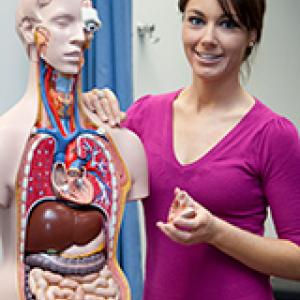
Clare Bodimeade
Anatomy is a three dimensional subject – you are able to show students what you’re explaining
As an anatomist, most of my days are spent preparing anatomical teaching specimens. Anatomy is a three dimensional subject – you are able to show students what you’re explaining, whereas many other disciplines, such as quantum physics, are far more conceptual. Anatomy cannot be understood from looking at a two dimensional image or reading a description in a text book. It’s equivalent to a mechanic trying to learn how an engine fits together by just studying from a book. With anatomy it is impossible to appreciate and understand how bones, muscles, nerves and blood vessels work together unless you can trace their path. Many structures undulate over, under, around and through others, so being able to see this first hand on a specimen is invaluable. Although human evolution hasn’t changed anatomy greatly in recent times, there is always variation between individuals; as such I am constantly learning and being surprised by the human body.
The Forensic Biology degree at UTS has a strong foundation in the bio-medical sciences, with the inclusion of Crime Scene, Human Remains and DNA Profiling. There are study areas in haematology (which is the study of blood), epidemiology (the study of disease), histology (the study of tissues), immunology (the study of the immune system), microbiology (which is the study of microscopic organisms) and molecular biology as well as many other medical science disciplines to choose from. The forensic biology degree is almost like doing a biomedical science degree but with a forensic element. This provides a versatile platform from which to build a career in many areas. An interesting bio-medical science option is anatomical pathology, which involves working with tissues samples. This can be a very rewarding career because sometimes surgeons need lab tests done on tissue from patients who are still on the operating table. These tests need to be accurate and fast, and they often provide the information that will save the patient’s life. Career options for forensic biology graduates may include all the bio-medical options as well as specific forensic areas. There is the research and teaching field, such as what I do, but also DNA profiling, other areas of human identification and of course one of the more popular career paths is to work for the police either in a lab-based capacity or as a scene of crime officer.

I find my work rewarding, inspiring and I continue to be fascinated by the way the human body works. I feel that it is really important to have anatomy resources for students, as the students I teach will go on to careers where they propagate health within the community in many different ways. Forensics is such a broad field with so many options available, however one thing is consistent across them all; you will certainly have an interesting and challenging career...although crimes are not solved within a one hour episodes!
Find out more about the Bachelor of Forensic Science.
